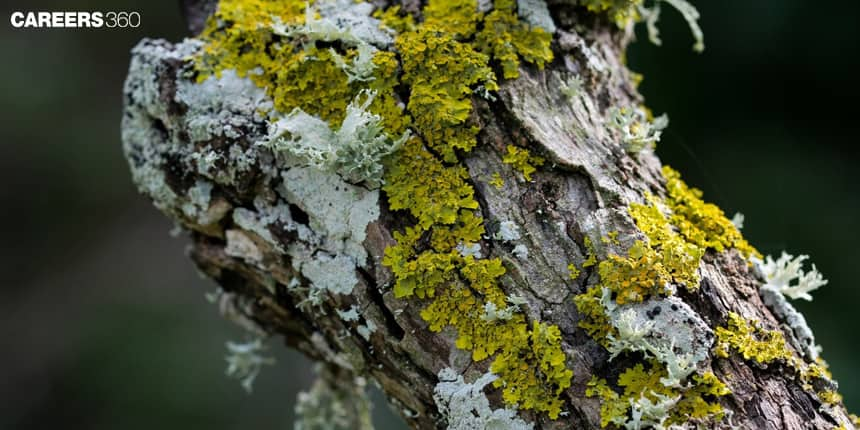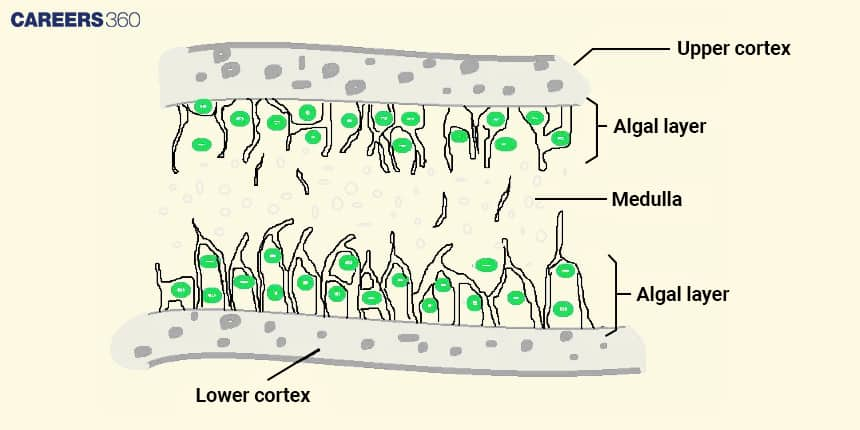Lichen: Definition, Types, Characteristics, History & Ecology
Lichen definition: Lichens are symbiotic organisms consisting of a fungus (mycobiont) and algae or cyanobacteria (photobiont). These organisms live together, offering mutual benefits to each other. The study of lichens is important because they are indicators of environmental health and soil-forming. They provide examples of symbiotic relationships and adaptive strategies under severe environmental conditions. Lichens is a topic of the chapter Biological Classification in Biology.
NEET 2025: Mock Test Series | Syllabus | High Scoring Topics | PYQs
NEET Important PYQ's Subject wise: Physics | Chemistry | Biology
New: Meet Careers360 B.Tech/NEET Experts in your City | Book your Seat now
- What is Lichen?
- Structure of Lichens
- Types of Lichens
- Ecology of Lichen
- Reproduction and Life Cycle of Lichen
- Symbiotic Relationship
- Adaptations of Lichen
- Uses of Lichen
- Conservation and Threats
- Recommended Video on Lichens

What is Lichen?
Lichens are the association of two different organisms that result in symbiosis, meaning that lichens are composite organisms formed by a fungus. This enables lichens to live in very different environments and contributes to each one's survival and adaptation to the organism. More specifically, this implies that while structure, protection, and nutrient supply are guaranteed through the fungus, photosynthesis goes on in the photobiont by producing sugar and oxygen gas for both partners.
Lichen Diagram
The diagram given below shows the position of the components of the lichen.

Structure of Lichens
The structure of lichens is composed of a thallus, which is the vegetative body of the organism. The thallus consists of a mass of intertwined fungal hyphae called the mycobiont and provides the structure and protection. The photobiont is embedded within the mesh of fungal hyphae: algae or cyanobacteria perform photosynthesis to produce carbohydrates that nourish both partners. This kind of symbiosis forms one integral whole in which the two components, fungus and alga, working together, adapt to the environment and survive under a wide spectrum of conditions.
Types of Lichens
The types of lichens based on the growth forms, broadly classify them into three main categories, which are as follows:
Foliose lichens: They have a leafy, nearly loose attachment to substrates, thus making them usually leafy in appearance.
Fruticose lichens: are generally bushy or shrub-like, branched, and rise upright from the substrate.
Crustose lichens: form tightly attached patchy crusts to the substrate surface and therefore are always flat or, at best, slightly raised.
Also read-
Ecology of Lichen
They have different ecology, in which they colonise terrestrial environments, growing on soil, or as epiphytes on trees and shrubs. They play a very integral role in ecosystems, acting to a great extent as bioindicators of air quality and environmental health by showing sensitivity to pollutants. Furthermore, lichens are pioneer species of ecological succession; that is, they may easily settle on bare substrates, participate in soil creation, enhance nitrogen fixation, and stabilise substrates. They greatly contribute to increasing biodiversity and the resilience of ecosystems.
Reproduction and Life Cycle of Lichen
Lichens reproduce both asexually and sexually. Asexual reproduction is by the dispersal of fungal fragments or specific reproductive structures. The soredia is richly filled with both fungal and algal cells and thus gives rise to new lichens in appropriate habitats. Sexual reproduction has the fusion of a fungal and an algal reproductive cell whereby spores are formed that—on germination—give rise to new lichen thalli.
The life cycle of lichens includes an alternation of generations. The dominant phase is a thallus; it is the haploid, or n, generation and consists of a symbiotic relationship between fungal and algal cells. Sexual reproduction produces a diploid, or 2n, zygote from the fusion of fungal and algal cells. This zygote develops into a structure called an ascocarp, within which meiosis occurs to produce haploid spores. These spores spread and germinate into new lichen thalli upon reaching suitable conditions, repeating their life cycle.
Symbiotic Relationship
Lichens are a symbiotic association of mutualism between one fungus, the mycobiont, and one algae, or cyanobacteria, photobiont. This fungus provides structure, protection, and access to environmental moisture and minerals. The algae or cyanobacteria perform photosynthesis in repayment and produce sugar and oxygen for both partners. Such mutual exchange of nutrients is a way to explain the survival of lichens, especially in very harsh habitats.
Adaptations of Lichen
Lichens have special adaptations to exist in extreme environments, such as deserts and polar areas, due to the ability to enter a dormant state during harsh conditions and be photosynthetically active at low temperatures. They possess special biochemical mechanisms that enable them to tolerate such pollutants as heavy metals and sulfur dioxide, thereby being good bioindicators of air quality. This sensitivity of their responses to environmental changes reinforces their potential for monitoring ecosystem health and as indicators of those areas affected by the activities of humans.
Uses of Lichen
Traditionally, lichens have been used for their historic and cultural value as dyes for food and textiles, in addition to traditional forms of medicine around the world. Lichens contribute towards medicine and industry through their bioactive compounds, notably lichen acids, that find application in pharmaceuticals for treating infections and inflammation. Modern applications of lichens in the production of natural dyes and perfumes outline their importance, hence stretched in both traditional and modern times.
Conservation and Threats
Lichens, across the world, have different conservation statuses. Many species are threatened by several dangers because they are sensitive to habitat loss due to urbanisation, agriculture, deforestation, climate change, changes in precipitation regimes, and increased temperatures. This habitat loss will even further minimise space available for lichens to colonise. Therefore, in such cases, conservation will play a very imperative role in the preservation of lichen diversity, as it does important functions in ecosystems and acts as an indicator of environmental health.
Also Read-
| Cell Envelope | Five Kingdom Classification |
| Composition of Bacterial Cell Wall | Kingdom Monera, Protista And Fungi |
| Gram Staining | Salient features of the Kingdom Monera |
Recommended Video on Lichens
Frequently Asked Questions (FAQs)
The symbiotic union in a lichen is that of a fungus, the mycobiont, with either algae or cyanobacteria forming the photobiont.
Lichens reproduce asexually, by fragmentation and soredia, and sexually by forming spores.
Lichens are ecologically important in that they work as indicators of air quality, contribute to nutrient cycling, and act as pioneer organisms in the process of ecosystem succession.
Medicinally, lichens have been mainly used for antibiotic properties and also in traditional remedies to cure wounds and infections.
Habitat destruction due to urbanisation and agriculture, gaseous pollution, and climate change are a few of the many threats facing lichen populations.
Also Read
30 Nov'24 12:23 PM
28 Nov'24 05:34 PM
25 Nov'24 05:18 PM
23 Nov'24 10:02 AM
22 Nov'24 01:59 PM
21 Nov'24 04:58 PM
16 Nov'24 01:58 PM